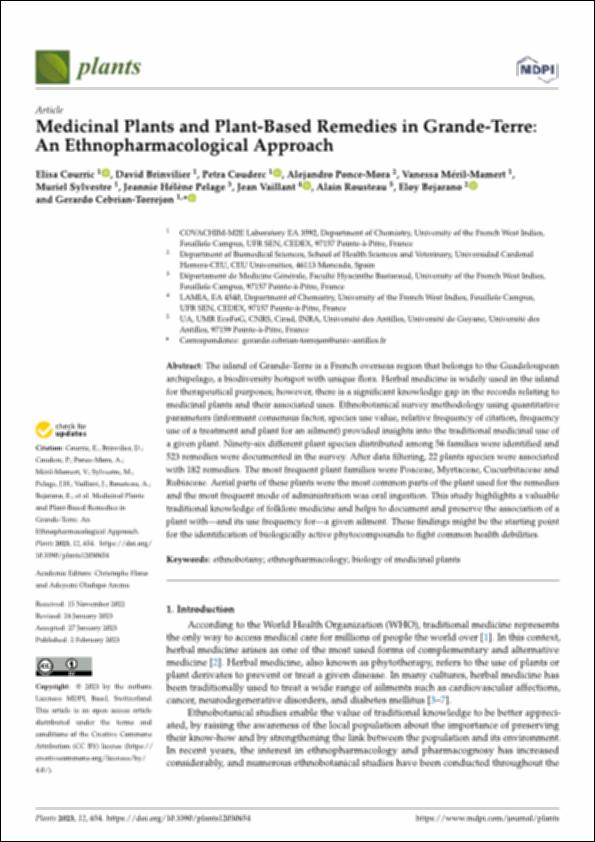Please use this identifier to cite or link to this item:
http://hdl.handle.net/10637/15196Medicinal plants and plant-based remedies in grande-terre: an ethnopharmacological approach
| Title: | Medicinal plants and plant-based remedies in grande-terre: an ethnopharmacological approach |
| Authors : | Courric, Elisa Brinvilier, David Couderc, Petra Ponce Mora, Alejandro Méril Mamert, Vanessa Sylvestre, Muriel Pelage, Jeannie Hélène Vaillant, Jean Rousteau, Alain Bejarano Fernández, Eloy Cebrián Torrejón, Gerardo |
| Keywords: | Planta medicinal; Medicinal plants; Etnobotánica; Ethnobotany; Farmacología; Pharmacology |
| Publisher: | MDPI |
| Citation: | Courric, E., Brinvilier, D., Couderc, P., Ponce-Mora, A., Méril-Mamert, V., Sylvestre, M., Pelage, J.H., Vaillant, J., Rousteau, A., Bejarano, E. & Cebrian-Torrejon, G. (2023). Medicinal plants and plant-based remedies in grande-terre: an ethnopharmacological approach. Plants, vol. 12, i. 3, art. 654 (02 feb.). DOI: https://doi.org/10.3390/plants12030654 |
| Abstract: | The island of Grande-Terre is a French overseas region that belongs to the Guadeloupean archipelago, a biodiversity hotspot with unique flora. Herbal medicine is widely used in the island for therapeutical purposes; however, there is a significant knowledge gap in the records relating to medicinal plants and their associated uses. Ethnobotanical survey methodology using quantitative parameters (informant consensus factor, species use value, relative frequency of citation, frequency use of a treatment and plant for an ailment) provided insights into the traditional medicinal use of a given plant. Ninety-six different plant species distributed among 56 families were identified and 523 remedies were documented in the survey. After data filtering, 22 plants species were associated with 182 remedies. The most frequent plant families were Poaceae, Myrtaceae, Cucurbitaceae and Rubiaceae. Aerial parts of these plants were the most common parts of the plant used for the remedies and the most frequent mode of administration was oral ingestion. This study highlights a valuable traditional knowledge of folklore medicine and helps to document and preserve the association of a plant with—and its use frequency for—a given ailment. These findings might be the starting point for the identification of biologically active phytocompounds to fight common health debilities. |
| URI: | http://hdl.handle.net/10637/15196 |
| Rights : | Open Access http://creativecommons.org/licenses/by/4.0/deed.es |
| ISSN: | 2223-7747 (Electrónico) |
| Issue Date: | 2-Feb-2023 |
| Center : | Universidad Cardenal Herrera-CEU |
| Appears in Collections: | Dpto. Ciencias Biomédicas |
Items in DSpace are protected by copyright, with all rights reserved, unless otherwise indicated.


